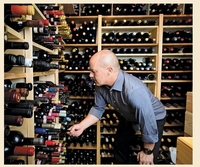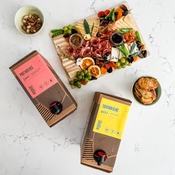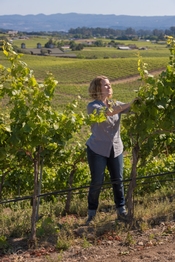|
|
 |
|
November 27, 2022
 With December just around the corner, along with lots of entertaining and office parties and end-of-year holidays, you might benefit from some wine pairing principles that will greatly ensure your odds for success. Getting good pairings is really not difficult if you keep a few key ideas in mind, and the ideas that are most helpful are neither difficult to remember nor confining when you're buying in a retail shop or choosing from a restaurant wine list: With December just around the corner, along with lots of entertaining and office parties and end-of-year holidays, you might benefit from some wine pairing principles that will greatly ensure your odds for success. Getting good pairings is really not difficult if you keep a few key ideas in mind, and the ideas that are most helpful are neither difficult to remember nor confining when you're buying in a retail shop or choosing from a restaurant wine list:
1) Get Robustness in Balance: This is by far the single most important point. A good marriage between wine and food entails an equal partnership in which neither participant dominates the other. If the wine overwhelms the food (as Cabernet overwhelms oysters, for example), the result is a failure. If the wine cannot hold its own with the food (as Sauvignon Blanc cannot hold up to steak), it cannot contribute to an enjoyable match. Balance is our goal, but what exactly are we trying to balance? In a word, the robustness of the food and the wine. Drawn out a bit, this means that the sheer "size" and flavor impact of the two must be roughly proportional for a good match to result.
This is not so hard to achieve. Anybody who eats can distinguish the differing robustness levels of different foods, and even a novice taster needs just a sip to learn that certain grapes and growing regions produce "bigger" or "smaller" wines that can be sized appropriately to any dish.
2) Forget Color: The old rule of pairing white wines with fish and red with meat will, if you think about it, often run afoul of the rule of getting robustness in balance. The fact is that a thick, grilled tuna steak is more robust than thin, sautéed slices of veal tenderloin. Many people will find that a light red like Pinot Noir works much better than a white with that tuna steak, just as a substantial white may be a better choice than a red for the veal.
3) Tend to Texture: Wines differ from one another in texture, and the texture of a wine isn't quite the same as its sheer "size." For example, a Shiraz or Zinfandel can be just as "big" as a Cabernet Sauvignon while nevertheless being much "softer" or "rounder" in texture. Foods also differ quite importantly in texture, and this variable really makes a difference in getting great results from pairings. Interesting textural matches can be either complementary or contrasting. For example, a rich dish like lobster with drawn butter can be matched successfully with a soft, "buttery" Chardonnay that complements its texture, or with a leaner, more "edgy" dry Riesling that offers a textural contrast.
4) Use Fat to Buffer Tannin: We can use certain properties in foods or wines to counterbalance potentially problematic elements in one another. High levels of tannin in wines like Cabernet Sauvignon or Barolo can make them seem astringent or bitter to most tasters, but foods with dietary fat (such a cheese or steak) can greatly reduce these sensations. Similarly, dishes that might seem too softly fatty for some people (such as a stew or a prime rib steak) will benefit from the structure lent by a tannic wine. Tannic wines don't work well with spicy foods (more on this below), but they love fatty ones.
5) Use Acidity to Neutralize Acidity: You might guess that pairing an acidic wine with a food loaded with vinegar or citrus juice would produce an overload of acid, but often the reverse is true. A zesty Sauvignon Blanc will actually make a bright vinaigrette dressing seem less tart than a lower-acid Chardonnay would. Likewise, a bright Albariño that would seem sour to some tasters will seem less tart if paired with a dish incorporating some lemon juice. Counter-intuitive though this principle may be, tasting is believing.
6) Use Sweetness to Counterbalance Hot Spice: If a lethally hot pepper flies in under your radar when you are eating in a Thai restaurant, your natural inclination will be to grab for your water. However, experience shows that you'd actually be better off reaching for the sugar bowl. Sweetness takes the edge off of hot spice, whether from curry or pepper. This is the principle that underlies the nearly universal recommendation of pairing spicy Asian foods with sweetish renditions of Riesling, Chenin Blanc, Gewurztraminer or Pinot Gris.
7) To Soothe Spicy Meats, Use Fruit in Reds to Substitute for Sweetness in Whites: Over time I’ve forsaken the simple cooked meats of my Chicago upbringing in favor of spicy preparations inspired by the cuisines of China, India, Thailand, Vietnam, North Africa, Turkey, Mexico, the Carribean…and beyond. These preparations are much more interesting to my taste, but also a little more challenging for wine pairing purposes.
Sweet whites are sometimes surprisingly workable, but only in a limited number of cases (e.g., if the meat is thinly sliced and there’s a sweet marinade involved along with the heat in the finished dish, as in certain Vietnamese or Korean foods). If the meat is more substantial and there’s no sweetness in the preparation, you’re likely to find red wines much more satisfying than whites. Reds with overt sweetness are rare and, when found, often foul, so the solution lies elsewhere: Not in sweetness itself, but rather the impression of sweetness left behind after fermentation by ripe fruit. Look to a sunny, New World source like California or Australia and a fruity grape variety like Pinot Noir, Grenache, Syrah or Zinfandel. The last trick is to buy bottles that don’t cost a lot of money, which will help you avoid wines that are seriously tannic or oaky. Tannin and oak obscure fruit and fail to harmonize with hot spice, so if you really care about how your red wine will taste with your spicy meat, keep the wine simple and fruity and forget the bells and whistles.
8) Don't Forget Bubbles: Many novices don't really think of sparkling wines as wines--much less as great food wines. However, Champagnes and high-quality sparklers can be stars at the table. Almost all have a bit of sweetness, and though this tends to be masked by effervescence, it can sometimes counterbalance a bit of spice or flatter a bit of salt in certain dishes in a more subtle and effective way than any table wine. Moreover, bubbles provide a unique texture that plays into principle #3 above. As a consequence, bubbly wines can provide a marvelous textural counterpoint to soft, smooth soups.
9) Keep It Simple for Dessert: Whether made from grapes that are harvested very late, freeze concentrated, or botrytis affected, sweet dessert wines are among the most wonderful treasures of the vine. However, it is very difficult to get the sweetness of desserts and dessert wines into a balance that doesn't make one or the other seem awkward. Another problem is that complex desserts often produce a cacophony when paired with high-end dessert wines, which are themselves among the most complex wines you can buy.
A solution to these problems that flatters the wine while also proving less heavy at the end of a meal is to order (or prepare) the simplest possible desserts. Yes, ports can work with chocolate desserts, but the pairings fail as often as they work, whereas a few walnuts and a little Stilton is always a delicious match. Similarly, a top Sauternes or Auslese will sometimes hit the mark with a fruit tart, but it will never miss with some simple shortbread cookies. And if anyone around your table claims to have a still-unsatisfied sweet tooth, you could always uncork another bottle.
Posted by Michael Franz at 11:59 AM
|
|
November 25, 2022
Boxed wine is no
newcomer to the wine scene, but innovators like Jake Whitman, Founder,
and CEO of Really Good Boxed Wine, have recast the underestimated boxed
format into a compelling field of its own, reaching  beyond the familiar Franzia to include premium California wines that fuse quality and quantity for blockbuster performance. beyond the familiar Franzia to include premium California wines that fuse quality and quantity for blockbuster performance.
Whitman, a Cincinnati native, honed his business
and brand skills as the Head of Marketing for SoFi Money. Before SoFi,
he worked at Intuit on the corporate marketing team and spent several
years at Procter & Gamble as a Brand Manager. He also wrote and
self-published Destination Teach For America, where he offers an insider look at the Teach For America application process.
I recently sat down with Whitman to discuss the genesis of Really Good
Boxed Wine, the advantages of the box format, and what's next for his
enterprising brand.
Whitman, his wife, and friends turned to boxed
wine during the pandemic and were disappointed in the existing quality
of box wine. Whitman asked himself the fundamental question, is there
an inherent reason why high-quality wines can't be served in a box?
Whitman noted, "it was something I’d been tossing around in my mind for a
while, but I always assumed there was a technical reason why you
couldn’t do it."
He found that there was no reason that high-quality wine couldn't be
served in a box – except for sparkling wine and aged wine. He started
learning everything he could about the box format, how it works, and how
it keeps the wine fresh. From there, Whitman called his friend, Allie
Ketcham, owner of Ketcham Estate. Whitman noted that "Allie had become a
good friend of mine, and she and her team make some of my favorite
Pinot Noirs in the world." Allie put him in touch with Healdsburg
Custom Crush in Sonoma County, where he secured a winegrower license.
The brand's test launch was held in Cincinnati in August 2021 with a
Ketchem Vineyard Pinot Noir hand-filled into 3-liter boxes. It sold out
in days. A successful national pilot followed, and from there, the
brand has flourished with the release of a Paso Robles Cabernet, a
Russian River Valley Pinot Noir Rosé, a Sonoma County Sauvignon Blanc,
along with an endorsement from Andy Myers, Master Sommelier.
The success can largely be attributed to fine quality, eco-friendly
packaging, and competitive prices. There are many compelling benefits
to the box format, as Whittman noted: "The first is that it stays fresh
for six weeks  when
you open it." Additionally, the box format can significantly reduce
carbon emissions by comparison to bottles. A box of wine weighs about
the same as two bottles, so packaging and shipping costs are
significantly lower. One 3 Liter box of Really Good Boxed Wine is the
equivalent of four bottles of wine…and costs $65. "If you're used to
spending $30 for a bottle on the weekend, here's the same wine at $15
for you to enjoy all week," Whitman explained. "And if you typically
spend $15 on a bottle, here's a wine worth twice as much you can get for
the same price." when
you open it." Additionally, the box format can significantly reduce
carbon emissions by comparison to bottles. A box of wine weighs about
the same as two bottles, so packaging and shipping costs are
significantly lower. One 3 Liter box of Really Good Boxed Wine is the
equivalent of four bottles of wine…and costs $65. "If you're used to
spending $30 for a bottle on the weekend, here's the same wine at $15
for you to enjoy all week," Whitman explained. "And if you typically
spend $15 on a bottle, here's a wine worth twice as much you can get for
the same price."
And this is just the beginning. Next month, Whitman will feature a
Pinot Noir from the San Luis Obispo Coast, the newest American
Viticultural Area (AVA) that benefits from the Pacific Ocean's
influence. The area was awarded the designation on March 9, 2022,
making Really Good Box Wine one of the first (if not the first)
wines under the new AVA. This summer, Whitman will also launch a
co-branded collaboration series with award-winning Napa winemakers.
Whitman proves that oenophiles should take a second look at the box
format. With wine this good (really good), it's a no-brainer. You can
snag your box directly from the Really Good Box Wine website, delivering
to 39 states and the District of Columbia. Retail sales are
forthcoming in OH, KY, and VA.
Posted by Miranda Franco at 7:31 AM
|
|
November 23, 2022
The one thing I know about you for sure is that you read wine websites, and that gives me very good odds of being correct about one other thing: You are probably the most wine-knowledgeable person attending your meal for Thanksgiving, and in turn, that probably means you’re responsible for bringing the wine.
If you plan to take that responsibility seriously, you’d do well to press past the many particular recommendations being offered at the moment to consider why certain wines work much better with this meal than others. Although that may sound like more work than you need right during this busy season, you’ll actually be freed up by learning some pairing principles, as they’ll enable you to select from a very wide range of wines with strong assurance of success.
1) Turkey’s flavor is relatively subtle, so wines with a lot of intensity and power can overwhelm it. Different preparations count, though, such as smoking the bird, but this is still not a meal suited to overly pushy wines.
2) Most households will have wine novices at the table, so intense wines are doubly inadvisable, as are tannic ones. Tannic wines also don’t work well because there’s not a lot of dietary fat in most turkey preparations, even though some people put lots of butter into side dishes like mashed potatoes.
3) Although really big wines don’t make sense with this meal, don’t go too small. Dark meat with gravy is much more robust than white meat without gravy, so quite light wines like Sauvignon Blanc or Pinot Grigio could be overwhelmed. This is a very important factor because some diners much prefer dark or light meat, and these preferences don’t always coincide with preferences for red or white wine.
4) Many households with large gatherings will include guests who much prefer either whites or reds, so including one of each is wise, even if as few as 4 are around the table.
5) Medium body and moderate robustness is the right road to success, and avoiding any characteristics that are sharply prominent (e.g., acidity, wood, sweetness, tannin) is important because of the complexity of the meal.
6) This complexity stems mostly from the side dishes, which matter…a lot. Cranberries are usually tart or sweet or both. Sweet potatoes are … um… sweet. Mashed potatoes are rich. Stuffing is too, almost regardless of the components. Green vegetables can range from pungent to bright. The only wines that can succeed with everything on a typical plate are thus integrated as well as medium bodied and moderately intense.
7) Integration can result from the character of the grape variety (e.g., Pinot Blanc) or from cellar techniques used or eschewed (malolactic fermentation to smooth out acidity, or wood ageing avoided to retain roundness and primary fruit). It can also result from ageing in reds, which softens tannin and leads to absorption of wood notes. However, the wine needs to have started its development with relatively acidity if it is to achieve integration from ageing without losing refreshment value. So, a cool climate Syrah from the northern Rhône can work well, but an aged Shiraz from Australia isn’t a great choice.
8) Although this isn’t a particularly fatty meal, it invariably ends up leaving everyone very full…if not downright comatose from tryptophan. So, successful wines always have some refreshment value, regardless of whether white or red. This is almost always stems from acidity, which in turn is almost always geographically associated with relatively cool climates. So, pick wines from a cool region, or ask a wine consultant in a retail shop to help you do that.
9) To help your guests perk up their appetites (and retain consciousness over the course of the meal), welcome them with very light wine. Sparkling wines make excellent aperitifs on any occasion, and are particularly appropriate for a celebration, but pick light ones. Rosé sparklers can be very good with the meal, but lighter Blanc de Blancs bottles are much better for starters. Regarding other before-dinner drinks, beer is filling and cocktails are befogging (and also enhance the likelihood of family fights). Nevertheless, hospitality requires that we accede to requests…even when based on bad ideas.
10) “Light is Right” holds equally true at the end of the meal. Finishing the dinner with something fresh and relatively light (like Riesling Auslese from Germany) is a better idea than Port, but if the dessert demands, Tawny is a much better choice than LBV or Vintage. However, if you have guests who want a Port or a Cognac after the meal, just be sure to have a sufficient number of guest rooms, couches or air mattresses to accommodate those who keel over.
Happy Thanksgiving from all of us at Wine Review Online!
Posted by Michael Franz at 12:07 PM
|
|
November 3, 2022
How often do you get to taste bottles of finished wines which are available to consumers that feature individual clones from a single vineyard?
A few weeks ago, that was the invitation I received – a Zoom session being held by Bouchaine Vineyards to try three bottles of Carneros-grown clones of Pinot Noir and one Pinot blend of various clones. And to make the  event even more interesting, the tasting would be led by the very talented Chris Kajani, who for the past eight vintages has been winemaker at Bouchaine after taking over when Michael Richmond retired. event even more interesting, the tasting would be led by the very talented Chris Kajani, who for the past eight vintages has been winemaker at Bouchaine after taking over when Michael Richmond retired.
Of course, nobody is more fascinated by the myriad clones of Pinot Noir than California winemakers. And, as a writer and wine lover, I am fascinated by their fascination.
Why are they so intrigued? Partly, I think, it’s a matter of history. Back in the 1970s, Napa Valley Cabernet Sauvignon winemakers seemed to quickly achieve parity with Bordeaux without having to steal cuttings from Lafite, Haut Brion or Margaux, or even reflect much at all about where their vines came from, what rootstocks they used or how they pruned and trellised their vines. They simply made Cabernets that in short order received reviews and prices that only Bordeaux had previously commanded. Many critics even began using Napa as a reference point as to what properly ripened Cabs should taste like.
Naturally, Pinot Noir planters said, “Why not us?” Even transplants adopted this West Coast can-do mentality in their quest to make Pinot Noirs that were the equal of those from Burgundy. It might take a little longer, they reasoned, maybe even five or six vintages. It was a matter of just finding the right terroir. So, they tried beside the bay, in the mountains, along the coast. Nice wines, but not Burgundy. Then they turned to clones. They didn’t work either, although some fabulous wines were being made.
So, wisely, most gave up on trying to be Burgundy. (Okay, maybe it could still be done if they could convince Aubert de Villaine to snip cuttings of his Romanée-Conti vines, hide them in his suitcase and personally plant then un-grafted when he flew back to his second home in the Carneros – no, probably not going to happen.) Instead, they decided to make California Pinot Noirs which could be pretty damn good in their own right.
Nevertheless, they retained their fascination with how Pinot Noir clones love to, well, clone. Plant those suckers in a vineyard, and 10 years later they would adapt and change accordingly. (Does your Joseph Swan look like my Joseph Swan?)
But I digress.
For the tasting, Kajani first pulled out her plot map of the 104-acre estate and its 97 acres of planted vines draped like a green quilt across the rolling bayside terrain. Listed on it were 12 Pinot Noir clones, some Dijon variants, as well as Swan, Pommard. Mt. Eden and Calera.
The first selection tasted was the 2019 Bouchaine “Swan Clone” Napa Valley Pinot Noir ($65). My abbreviated, jot-‘em-down notes were “very lean and very crisp – the most Burgundy-like of the three” to distinguish it from the others. As Kajani tasted, she said “nice structure, nice tension on the palate,” adding, “It was the last block picked, a late-ripener with bigger berries.”
Next was the 2019 Bouchaine “Pommard Clone” Napa Valley Pinot Noir ($65). Having tasted earlier, my notes were “fragrant and smooth, juicy, slightly fruity sweet.” Kajani said, “The Pommard has thick skins, so there’s a snap to the tannins even if the wine is creamy. I used more oak on this one, and I tell people this is the Pinot Noir for Cabernet lovers.” She took another sniff. “Another thing – as Pommard ages, it takes on a definite mocha flavor.”
The 2019 Bouchaine “Dijon Clone” Napa Valley Pinot Noir ($65) was the final of the three. My differentiating notes were “spicier, leaner, more tannins.” Kijani noted that it was the darkest of the clones and the first harvested. “This one is planted on volcanic soil,” Kajani says. “It has dark cheery flavors, but with a tea rose, spicy, floral note. There are a lot of tannins present.”
All were delicious. Of the three, I found the Dijon to be my favorite, although, like many dedicated drinkers, the wine I choose often has more to do with my mood and the occasion.
Some wineries like to make their blends to be the most-impressive and highest-priced, but the 2019 Bouchaine Napa Valley Pinot Noir ($40) – the estate wine – seems to be intended to be more of an accessible, entry-level starter Pinot leading to the others selections. My notes were, “not as fragrant, some savory hints, long on the palate – a versatile food wine.” Kajani said, “This was less about the oak and more about the balance – something to enjoy right now,” selected from about 20-some vineyard blocks. “Making it was like crazy Jenga – what to leave it, what to leave out,” she summed up. Or like a Bob Seeger lyric.
Finally, Kajani said, focusing on year and not just the clones, “I call 2019 the ‘Goldilocks’ vintage,” she says. “Not too cold, not too hot, but just right.” And “just right” might just describe Kijani’s approach to Pinot Noirs clones as well.
Posted by Roger Morris at 10:52 AM
|
|
 |
|